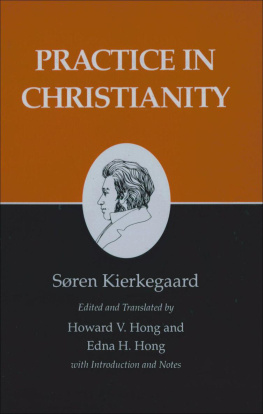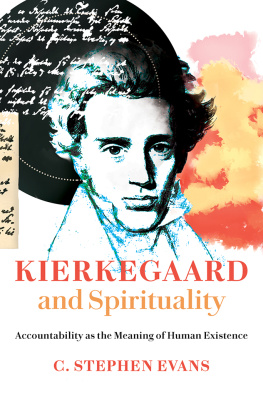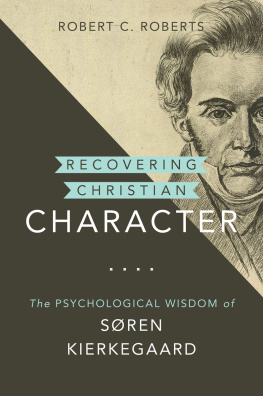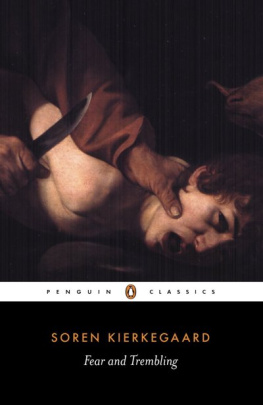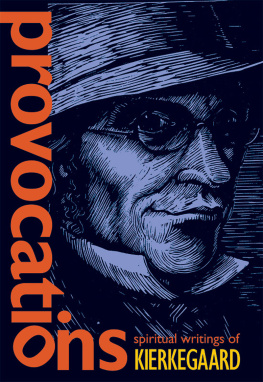PRACTICE IN CHRISTIANITY
KIERKEGAARDS WRITINGS, XX

PRACTICE IN CHRISTIANITY
by Sren Kierkegaard
Edited and Translated
with Introduction and Notes by
Howard V. Hong and
Edna H. Hong
PRINCETON UNIVERSITY PRESS
PRINCETON, NEW JERSEY
Copyright 1991 by Howard V. Hong
Published by Princeton University Press,
41 William Street, Princeton, New Jersey 08540
In the United Kingdom: Princeton University Press, Chichester, West Sussex
All Rights Reserved
Library of Congress Cataloging-in-Publication Data
Kierkegaard, Sren, 18131855
[Indvelse i Christendom English]
Practice in Christianity / by Sren Kierkegaard ; edited and translated with
introduction and notes by Howard V. Hong and Edna H. Hong
p. cm. (Kierkegaards writings ; 20)
Translation of: Indvelse i Christendom.
Includes bibliographical references and index.
ISBN 0-691-07396-1 ISBN 0-691-02063-9 (pbk.)
1. Christian life. 2. Psychology, Religious. 3. Atonement.
4. Grace. I. Hong, Howard Vincent, 1912 . II. Hong, Edna
Hatlestad, 1913 . III. Title. IV. Series: Kierkegaard, Sren,
18131855. Works. English. 1978 ; 20.
B4373. 1532E5 1991
248dc20 91-9575
Preparation of this volume has been made possible in part by a grant from the Division of Research Programs of the National Endowment for the Humanities, an independent federal agency
Princeton University Press books are printed on acid-free paper and meet the guidelines for permanence and durability of the Committee on Production Guidelines for Book Longevity of the Council on Library Resources
Designed by Frank Mahood
http://pup.princeton.edu
Printed in the United States of America
13 15 17 19 20 18 16 14 12
ISBN-13: 978-0-691-02063-1
ISBN-10: 0-691-02063-9
CONTENTS
HISTORICAL INTRODUCTION
At the end of 1847 and early in 1848, Kierkegaard again considered terminating his work as a writer and seeking an appointment as a country parish pastor
For him it was also an important period of self-understanding. How true it is to me now that all my recent productivity has actually been my personal upbringing, my humiliation. Youthfully I have daredthen it was granted to me to set forth the requirement of ideality in an eminent senseand quite rightly I am the one who feels humbled under it and learns in a still deeper sense to resort to grace.
The numerous manuscripts and his own sense of an inverse relation to their ideality plunged him into months-long wrestling with the question of publicationshould they be published, and also, some or all, and under his own name or under a pseudonym?
Eventually the two works ( The Sickness unto Death and Practice ) were published separately, The exclusion of a direct personal relation to the writings of 1848 meant not only the adoption of a pseudonym for the two works but also the withholding of Armed Neutrality and Point of View (although On My Work as an Author , a considerably modified and selective substitute for the latter, was published as a signed work on August 7, 1851, three years later). Two of the essays from the Cycle of Ethical-Religious Essays appeared May 19, 1849, under the pseudonym H. H. and with the title Two Ethical-Religious Essays. The Lily in the Field and the Bird of the Air was published under Kierkegaards name on May 14, 1849 (accompanied the same day by the second edition of Either/Or).
The new pseudonym chosen for Sickness unto Death and Practice was Anti-Climacus.
Retrospectively, Practice is related to the themes of The Concept of Anxiety and Philosophical Fragments and more directly to the theme of the first Anti-Climacus volume Sickness unto Death. In the first half of that work the various aspects of despair in itself are analyzed and described. The second half of the volume is an analysis of despair as sin and of the despairing self before God. Practice constitutes the third part of the sequence, the healing of the sin-conscious self and the indicative ethics gratefully expressive of the redemptive gift.
In May 1848, Kierkegaard did indeed consider forming a single volume that would include all three parts of the sequence:
... A new book ought to be written entitled: Thoughts That Cure Radically, Christian Healing .It will deal with the doctrine of the Atonement. First of all it will show that the root of the sickness is sin. It will have two parts. [ Deleted: Perhaps it is better to have three.First comes:(1) Thoughts that wound from behindfor upbuilding. This will be the polemical element, something like The Cares of the Pagans, but somewhat stronger; Christian discourses should be given in an altogether milder tone.](1) [ changed from: (2)] On the consciousness of sin. The Sickness unto Death
Christian Discourses
(2) [ changed from: (3)] Radical Cure
[ changed from: Thoughts That Cure Radically]
Christian Healing
The Atonement
The original Part One was not written. The subtitle Thoughts That Wound from Behind had been used in Christian Discourses (April 26, 1848) as the heading of Part Three. The first of the remaining two parts was published (July 30, 1849) as The Sickness unto Death , and the second, Radical Cure, became Practice in Christianity (September 25, 1850).
In relation to later writings, Practice , together with For Self-Examination and the posthumously published Judge for Yourself , constitutes the beginning of Kierkegaards attack on the established order of Christendom. Initially, however, he regarded Practice as a defense.
In On My Work as an Author , Kierkegaard affirmed that Practice was a corrective defense of the established order: Provided an ecclesiastical established order understands itself, it will to the same degree understand the latest book, Practice in Christianity , as an attempt to find, ideally, a basis for an established order, and that the preface expresses [this] directly by stating my understanding of the book. But the nature of the book lends itself also to understanding it as an attack.
It cannot be said directly that the book (except for the editors preface, which stands by itself) is a defense of the established order, since the communication is doubly reflected; it can also be just the opposite or be understood as such. This is why I directly say only that an established order that understands itself must understand it in this way; all doubly reflected communication makes contrary understandings equally possible; thus the one who passes judgment is disclosed by the way he judges.
Bishop Mynster and Kierkegaard had conversations about the book, and he reaffirmed that on the basis of an admission it was a defense of the established order. If, however, it had been initially published in 1855, it would, with two omissions and one change, have become an attack, because the admission had not been forthcoming and the situation was essentially unchanged.
If it were to come out now, now when both pious consideration for the late bishop has lapsed and I have convinced My earlier thought was: if the established order can be defended, this is the only way to do it: by poetically (therefore by a pseudonym) passing judgment on it, by then drawing on grace in the second power, Christianity would become not only finding forgiveness for the past by grace , but by grace a kind of indulgence from the actual imitation of Christ and the actual strenuousness of being Christian. In this way truth still manages to come into the established order; it defends itself by judging itself; it acknowledges the Christian requirement, confesses its own distance, yet without being able to be called a striving in the direction of coming closer to the requirement, but resorts to grace also in relation to the use one makes of grace.In my opinion this was the only way Christianly to defend the established order; and lest I in any way incur the guilt of setting to work too fast I dared to give the matter this turn in order to see what the old bishop would do about it If there was power in him, he would have to do one of two things either decisively declare himself for the book, venture to go along with it, let it be the defense that wards off what the book poetically contains, the charge against the whole official Christianity that it is an optical illusion not worth a pickled herring, or as decisively as possible throw himself against it, stamp it as a blasphemous and profane attempt, and declare the official Christianity to be the true Christianity. He did neither of the two, he did nothing; he only wounded himself on the book; and to me it became clear that he was powerless.Now, however, I have completely made up my mind on two things: both that the established order is Christianly indefensible, that every day it lasts it is Christianly a crime; and that in this way one does not have the right to draw on grace.Thus, take away the pseudonym, take away the thrice-repeated Moral to No. 1: then Practice in Christianity is, Christianly, an attack upon the established order; but out of pious consideration for the old bishop and out of cautious slowness it [the attack] was concealed in the form of: the final defense of the established order.Incidentally, I am well aware that the old bishop saw the attack in this book; but, to repeat, he powerlessly chose to do nothing more than condemn it in the living room, but not once in private conversation with me, despite my asking him to do it after I was told of his verdict in the living room.April [30] 1855 S. Kierkegaard
Next page
